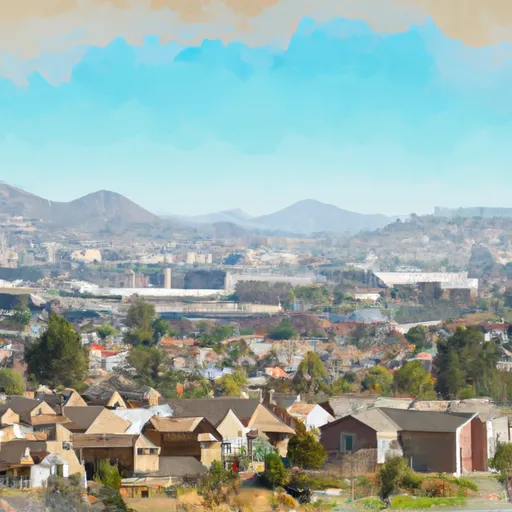-
 Snoflo Premium
Snoflo Premium
Get unlimited access to all our content
With no Ad interruptions! - Start Your Free Trial Login with existing account
Murrieta
Eden Index
Climate
8.9
•
Recreation
6.4
•
Community
3.7
•
Safeguard
6.7/10

Murrieta, California is a vibrant city located in Riverside County, in the southwestern part of the state. The city has a Mediterranean climate, characterized by hot, dry summers and mild winters. Summers can reach temperatures in the high 90s°F (35-37°C), while winters typically see highs in the 60s°F (15-20°C). The region experiences very low precipitation, with most rainfall occurring between November and April.
Hydrologically, Murrieta lies within the Santa Margarita River watershed, which is an important water source for the area. However, the city itself does not have any significant bodies of water within its limits. The Santa Rosa Plateau Ecological Reserve, located nearby, offers a unique outdoor recreation opportunity for nature enthusiasts. It features diverse habitats, such as oak woodlands, grasslands, and vernal pools, providing opportunities for hiking, bird watching, and nature photography.
Additionally, Murrieta has several well-maintained parks and recreational facilities, offering activities such as picnicking, sports fields, playgrounds, and walking trails. With its pleasant climate and proximity to natural beauty, Murrieta provides ample opportunities for outdoor recreation and enjoyment of the surrounding environment.
What is the Eden Index?
The Snoflo Eden Index serves as a comprehensive rating system for regions, evaluating their desirability through a holistic assessment of climate health, outdoor recreation opportunities, and natural disaster risk, acknowledging the profound impact of these factors on livability and well-being.
Climate Health Indicator (CHI): 8.9
Murrieta receives approximately
343mm of rain per year,
with humidity levels near 46%
and air temperatures averaging around
18°C.
Murrieta has a plant hardyness factor of
9, meaning
plants and agriculture in this region tend to thrive here all year round.
By considering the ideal temperature range, reliable water supplies, clean air, and stable seasonal rain or snowpacks, the Climate Health Indicator (CHI) underscores the significance of a healthy climate as the foundation for quality living.
A healthy climate is paramount for ensuring a high quality of life and livability in a region, fostering both physical well-being and environmental harmony. This can be characterized by ideal temperatures, reliable access to water supplies, clean air, and consistent seasonal rain or snowpacks.
Weather Forecast
Streamflow Conditions
Laguna-San Diego Coastal
Area Rivers
Laguna-San Diego Coastal
Snowpack Depths
Laguna-San Diego Coastal
Reservoir Storage Capacity
Laguna-San Diego Coastal
Groundwater Levels
Recreational Opportunity Index (ROI): 6.4
The Recreational Opportunity Index (ROI) recognizes the value of outdoor recreational options, such as parks, hiking trails, camping sites, and fishing spots, while acknowledging that climate plays a pivotal role in ensuring the comfort and consistency of these experiences.
Access to outdoor recreational opportunities, encompassing activities such as parks, hiking, camping, and fishing, is crucial for overall well-being, and the climate plays a pivotal role in enabling and enhancing these experiences, ensuring that individuals can engage in nature-based activities comfortably and consistently.
Camping Areas
| Campground | Campsites | Reservations | Toilets | Showers | Elevation |
|---|---|---|---|---|---|
| Del Mar Beach Military | None | 13 ft | |||
| Upper San Juan | 18 | 1,761 ft | |||
| Lake ONeill Military | None | 135 ft | |||
| El Cariso | 24 | 2,568 ft | |||
| South Carlsbad State Beach | 220 | 68 ft | |||
| Wildomar | 11 | 2,456 ft | |||
| Oceanside Harbor | 40 | 14 ft | |||
| Guajome Park | 35 | 103 ft | |||
| Blue Jay | 50 | 3,358 ft | |||
| Dixon Lake | 45 | 1,062 ft |
Catastrophe Safeguard Index (CSI):
The Catastrophe Safeguard Index (CSI) recognizes that natural disaster risk, encompassing floods, fires, hurricanes, and tornadoes, can drastically affect safety and the overall appeal of an area.
The level of natural disaster risk in a region significantly affects safety and the overall livability, with climate change amplifying these risks by potentially increasing the frequency and intensity of events like floods, fires, hurricanes, and tornadoes, thereby posing substantial challenges to community resilience and well-being.
Community Resilience Indicator (CRI): 3.7
The Community Resilience Indicator (CRI) recognizes that education, healthcare, and socioeconomics are crucial to the well-being of a region. The CRI acknowledges the profound impact of these elements on residents' overall quality of life. By evaluating educational resources, healthcare accessibility, and economic inclusivity, the index captures the essential aspects that contribute to a thriving community, fostering resident satisfaction, equity, and social cohesion.

